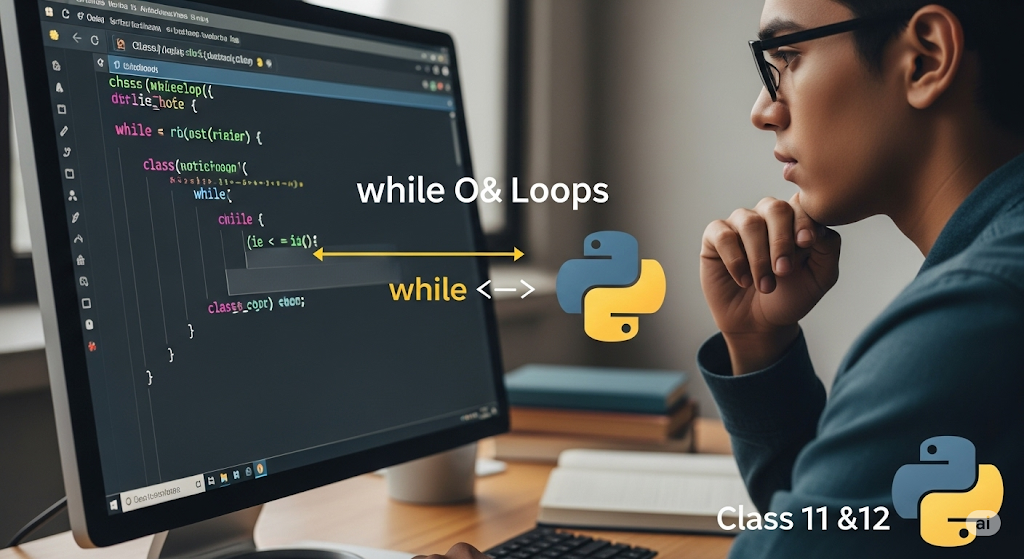Python Loops – While – Class 11 & 12
While Loops in Python with Examples
A while loop in Python repeatedly executes a block of code as long as a specified condition remains true. It’s useful when you don’t know in advance how many times you’ll need to iterate.
Basic Syntax
python
while condition:
# code to execute while condition is true
# don't forget to modify the condition variable!
Example 1: Simple Counter
python
# Count from 1 to 5
count = 1
while count <= 5:
print(f"Count: {count}")
count += 1 # Increment count to eventually make the condition false
print("Loop ended!")
Output:
text
Count: 1 Count: 2 Count: 3 Count: 4 Count: 5 Loop ended!
Explanation:
- Initialize
countto 1 - The loop runs as long as
count <= 5is true - Inside the loop, we print the current count and increment it
- When count becomes 6, the condition becomes false and the loop ends
Infinite Loops, break, and continue in Python While Loops
1. Infinite Loops
An infinite loop occurs when a while loop’s condition never becomes False, causing it to run indefinitely.
Example of Infinite Loop:
python
while True:
print("This will run forever!")
Common Causes:
- Forgetting to update the variable in the condition
- Incorrect loop condition
- Intentional design (like server loops)
Practical Use Case (Controlled Infinite Loop):
python
while True:
user_input = input("Enter 'quit' to exit: ")
if user_input.lower() == 'quit':
break
print(f"You entered: {user_input}")
2. The break Statement
break immediately terminates the entire loop, skipping any remaining iterations.
Example:
python
count = 0
while count < 10:
count += 1
if count == 5:
break
print(count)
# Output: 1 2 3 4
Common Uses:
- Early exit when a condition is met
- User requests to quit
- Error conditions
3. The continue Statement
continue skips the rest of the current iteration and moves to the next one.
Example:
python
count = 0
while count < 5:
count += 1
if count == 3:
continue
print(count)
# Output: 1 2 4 5
Common Uses:
- Skipping specific values
- Handling edge cases
- Avoiding nested if statements
Comparison Table
| Concept | Effect | When to Use |
|---|---|---|
| Infinite Loop | Runs indefinitely | Server loops, game loops |
break | Exits the loop completely | Early termination conditions |
continue | Skips to next iteration | Skip specific cases |
Best Practices
- Avoid accidental infinite loops by ensuring your condition will eventually become False
- Use
breaksparingly – it can make code harder to follow - Consider alternatives to
continuelike if-else statements when they improve readability - Always have an escape route for intentional infinite loops (like a
breakcondition)
Practical Example Combining All Three
python
while True: # Infinite loop
user_input = input("Enter a number (or 'done' to finish): ")
if user_input.lower() == 'done':
break # Exit the loop
if not user_input.isdigit():
print("Invalid input!")
continue # Skip to next iteration
number = int(user_input)
if number % 2 == 0:
print(f"{number} is even")
else:
print(f"{number} is odd")
This example shows:
- An infinite loop (
while True) - A
breakcondition to exit - A
continueto skip invalid inputs
The else Suite in Python’s while Loop
In Python, the while loop can have an optional else clause, which is executed when the loop condition becomes false. This is often called the “else suite” of the while loop.
Basic Syntax
python
while condition:
# loop body
else:
# else suite (executed when condition becomes false)
Key Points About the else Suite
- The
elseblock executes only if the loop completes normally (i.e., the condition becomes false) - It does not execute if the loop is terminated by a
breakstatement - It’s useful for situations where you want to execute some code when a loop finishes without finding what it was looking for
Simple Examples
Example 1: Basic while-else
python
count = 0
while count < 3:
print(f"Count is {count}")
count += 1
else:
print("Loop completed normally")
Output:
text
Count is 0 Count is 1 Count is 2 Loop completed normally
Example 2: With break statement
python
count = 0
while count < 3:
print(f"Count is {count}")
if count == 1:
break
count += 1
else:
print("Loop completed normally")
Output:
text
Count is 0 Count is 1
Notice the else block didn’t execute because we used break
Practical Example: Searching for an item
python
numbers = [1, 3, 5, 7, 9]
index = 0
while index < len(numbers):
if numbers[index] == 4:
print("Found 4!")
break
index += 1
else:
print("4 not found in the list")
Output:
text
4 not found in the list
When to Use while-else
The else suite is particularly useful for search loops where you want to:
- Take some action if the item is found (using
break) - Take a different action if the item isn’t found (in the
elseclause)
This pattern is cleaner than using flags to track whether a search was successful.
Notebook
While Loops in Python with Examples
A while loop in Python repeatedly executes a block of code as long as a specified condition remains true. It’s useful when you don’t know in advance how many times you’ll need to iterate.
Basic Syntax python
while condition: # code to execute while condition is true # don’t forget to modify the condition variable!
msg = input("enter string to print n times")
n = int(input("How many time repeat"))
i = 0
while i<n:
print(i+1,msg)
i += 1
print("loop ended")
1 ram 2 ram 3 ram 4 ram 5 ram 6 ram 7 ram 8 ram 9 ram 10 ram 11 ram 12 ram 13 ram 14 ram 15 ram 16 ram 17 ram 18 ram 19 ram 20 ram 21 ram 22 ram 23 ram 24 ram 25 ram 26 ram 27 ram 28 ram 29 ram 30 ram loop ended
Greet = "hi venkat"
# print(greet)
i = 0
while i<10:
i += 1
print(i,Greet)
print("*******")
1 hi venkat 2 hi venkat 3 hi venkat 4 hi venkat 5 hi venkat 6 hi venkat 7 hi venkat 8 hi venkat 9 hi venkat 10 hi venkat *******
# print 1 to N number
n = int(input("How many Number")) #10
i=1
while i<=n:
print(i)
i += 1
1 2 3 4 5 6
# print 1 to N even number
# print 1 to N number
n = int(input("How many Number")) #100
i=2
while i<=n:
print(i)
i += 2
2 4 6 8 10 12 14 16 18 20
i = 100
while i>=1:
print(i)
i -= 1
100 99 98 97 96 95 94 93 92 91 90 89 88 87 86 85 84 83 82 81 80 79 78 77 76 75 74 73 72 71 70 69 68 67 66 65 64 63 62 61 60 59 58 57 56 55 54 53 52 51 50 49 48 47 46 45 44 43 42 41 40 39 38 37 36 35 34 33 32 31 30 29 28 27 26 25 24 23 22 21 20 19 18 17 16 15 14 13 12 11 10 9 8 7 6 5 4 3 2 1
# Count from 1 to 5
count = 1
while count <= 5:
print(f"Count: {count}")
count += 1 # Increment count to eventually make the condition false
print("Loop ended!")
Count: 1 Count: 2 Count: 3 Count: 4 Count: 5 Loop ended!
Sum of First N Natural Numbers Using a While Loop in Python
#Sum of First N Natural Numbers
n = int(input("Enter a positive integer: "))
sum = 0
i = 1
while i <= n:
sum += i
i += 1
print(f"The sum of first {n} natural numbers is: {sum}")
The sum of first 10000 natural numbers is: 50005000
Sum of N Entered Numbers Using a While Loop in Python
n=int(input("enter n Vlue"))
sum=0
i=1
while i<=n:
k = int(input(f"Enter number {i}: "))
sum= sum + k
i = i+1
print (sum)
100
n = int(input("How many numbers do you want to sum? "))
sum_numbers = 0
count = 1 # Tracks how many numbers we've taken
while count <= n:
num = float(input(f"Enter number {count}: "))
sum_numbers += num
count += 1
print(f"The sum of the {n} numbers is: {sum_numbers}")
The sum of the 5 numbers is: 15.0
n = int(input("How many numbers do you want to compare? "))
count = 0
max_num = 0 # Initialize to smallest possible number
min_num = 99999999999999999999999999999999999999999999999999999999 # Initialize to largest possible number
while count < n:
num = float(input(f"Enter number {count + 1}: "))
if num > max_num: 45 >33
max_num = num # 45
if num < min_num: 45 < 22
min_num = num #22
count += 1
print(f"Maximum number: {max_num}")
print(f"Minimum number: {min_num}")
Maximum number: 66.0 Minimum number: 22.0
# Print multiplication table for number 5
num = int (input("number"))
i = 1
print(f"Multiplication table of {num}:")
while i <= 10:
print(f"{i} X {num} = {num * i}")
i += 1
#{num} x {i} =
Multiplication table of 88: 1 X 88 = 88 2 X 88 = 176 3 X 88 = 264 4 X 88 = 352 5 X 88 = 440 6 X 88 = 528 7 X 88 = 616 8 X 88 = 704 9 X 88 = 792 10 X 88 = 880
want to extract its last digit using a while loop in Python
# number = 45671
# last_digit = None
# while number > 0:
# last_digit = number % 10 # Gets the last digit
# number = number // 10 # Removes the last digit
# # Break after first iteration since we only need the last digit
# break
# print("Last digit:", last_digit) # Output: 5
a= 235//10 #23 5
a= a//10 #2 3
a= a//10 #
a
0
Count the Number of Digits and Sum of Digits in Python
number = -35695
count = 0
sum_digits = 0
temp = abs(number) # Handle negative numbers
print(temp)
while temp > 0: #3
last_digit = temp % 10 #3
sum_digits += last_digit #28
count += 1 #5
temp = temp // 10 #0
print(f"Number of digits: {count}")
print(f"Sum of digits: {sum_digits}")
35695 Number of digits: 5 Sum of digits: 28
#789
#987
num = int(input("Enter a number: "))
original = num
reverse = 0
# Reverse the number
while num > 0:
digit = num % 10 #
reverse = reverse * 10 + digit #7654
num = num // 10 #4
print(f"Reversed number: {reverse}")
# Check if palindrome
if original == reverse:
print(f"{original} is a palindrome!")
else:
print(f"{original} is not a palindrome.")
Reversed number: 7654 4567 is not a palindrome.
Infinite Loops
while True:
user_input = input("Enter 'quit' to exit: ")
if user_input.lower() == 'quit':
break
print(f"You entered: {user_input}")
You entered: hi
The break Statement
break immediately terminates the entire loop, skipping any remaining iterations.
count = 0
while count < 10:
count += 1
print(count)
if count == 8:
break
print("Python")
# if count == 5:
# break
1 2 3 4 5 6 7 8 Python
The continue Statement
continue skips the rest of the current iteration and moves to the next one.
count = 0
while count < 4:
count += 1
if (count == 2 or count == 3):
continue
print(count)
# Output: 1 2 4 5
1 4
while True: # Infinite loop
user_input = input("Enter a number (or 'done' to finish): ") #DONE
if user_input.lower() == 'done':
break # Exit the loop
if not user_input.isdigit():
print("Invalid input!")
continue # Skip to next iteration
number = int(user_input)
if number % 2 == 0:
print(f"{number} is even")
else:
print(f"{number} is odd")
Invalid input!
The else Suite in Python’s while Loop
In Python, the while loop can have an optional else clause, which is executed when the loop condition becomes false. This is often called the “else suite” of the while loop.
# while condition: # # loop body # else: # # else suite (executed when condition becomes false)
#Basic while-else
count = 0
while count < 3:
print(f"Count is {count}")
count += 1
else:
print("Loop completed normally")
Count is 0 Count is 1 Count is 2 Loop completed normally
With break statement
count = 0
while count < 3:
print(f"Count is {count}")
if count == 1:
break
count += 1
else:
print("Loop completed normally")
Count is 0 Count is 1


